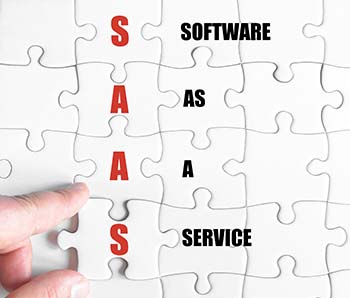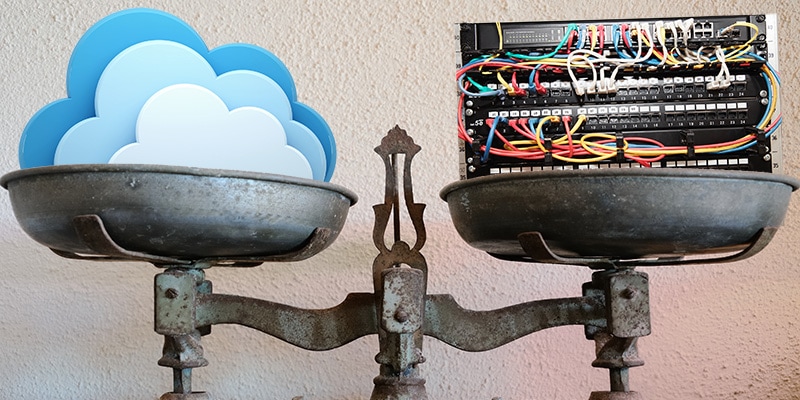As you’re considering intranet solutions, it’s important to look carefully at what will be the most practical for your company. Two very real options are a cloud-based intranets vs. installing your intranet on a company network. There are several advantages and disadvantages to each. Understanding the facets of those advantages and disadvantages will give you the knowledge base you need to make a decision about the intranet solution that best fits your company. It may also make your decision easier if you’re able to prioritize the details that matter most for your company.
Cloud-based Intranet Costs

Portability and Accessibility
How often do your employees need to access the company intranet when they’re on the road? Whether they’re accessing important documents, collaborating with coworkers back at the office, or simply checking in, a cloud-based intranet solution allows a much higher level of convenience for employees who aren’t based in the office. They can easily log in to the cloud from anywhere, accessing the information they need just as if they were sitting in a chair in their offices. With an intranet that is hosted within the building, it may be difficult or even impossible to access it from outside.
Cloud-based intranet also has a second accessibility advantage: it’s accessible no matter what’s happening within your office. If the power goes out, your intranet will still be accessible from laptops and mobile devices. If your in-house network comes down, your servers overheat, or you’re experiencing a weather emergency that makes it impossible for anyone to get into the office, the cloud-based service will still be up and running efficiently.
Ease and Speed of Deployment
When you need an intranet solution for your business, chances are, you need it up and running yesterday. When you use a cloud-based intranet provider, you can have things up and running quickly. Typically, you’ll be able to work from an existing template and easily add apps that are necessary for your company. You won’t need an in-house IT team to run it, either: a few people with administrative access to the intranet in addition to their regular duties are all it takes to keep things running smoothly on your end.

When you have your own in-house intranet that’s hosted on the company network, however, you’re the one in full control of it. You decide when the system is ready to go live. When you need to push upgrades, you can decide how and when it happens, even putting the new system out for a trial period before making it accessible to everyone. This will help in weeding out potential problems before they become a bigger issue.
Service and Problems
Most cloud intranet comes with a service contract, so you can easily contact their IT to handle any issues that may arise. They’ll know the system very well, since they work with several like it. The downside? You won’t have an in-house team to let you know immediately what’s going on when the system isn’t working the way you expect. You’ll have to use over-the-phone support instead of having someone come down in person and explain things to you, which might be more difficult for many people to get their minds wrapped around.
An in-house intranet, on the other hand, belongs to your company, and you’re the ones who will be expected to maintain it. You’ll have an on-site IT team who will walk you through any trouble that you’re having, and if need be, they can come in and go over the process with you in person. It’s much easier to access an IT team that’s just a short walk down the hall than it is to get to one in another state.
Boiling It Down: the Pros and Cons
Cloud-Based Intranet
Pros:
There’s a much lower up-front cost.
- No need to train IT personnel to maintain the intranet
- Portable: your employees can easily access it wherever they are.
- Access stays up even if your in-office network goes down or the power is out.
- Cloud-based intranet makes it easier to make changes and scale the size of your intranet without the need to buy more equipment.
- Cloud-based intranets can be deployed faster–including changes or growth in your existing system.
- The system is easily run by employees within your existing organization, rather than creating a need for new employees to run it.
Cons:
- Someone else owns your intranet solution, and you’ll have to pay every month to keep it up and running. Over time, this may add up to a much higher expense than the initial output to create an in-house system.
- You won’t have an in-house IT provider.
- You don’t have full control over when and how new upgrades will be released.
Intranet Hosted on the Company Network
Pros:
- Your intranet is yours to use as you will. There’s no need to keep paying each month to keep it running.
- You’ll have an in-house IT team to deal with anything that goes wrong–much more convenient than working with a team that works in another state.
- There’s no long-term cost associated with keeping your intranet up and working. It won’t have to be a line item in the budget every month.
- You’ll have full control over changes and deployments, enabling you to time things in a way that will work best for your company, not the way that works best for someone else’s schedule.
- You have full ownership, creativity, and flexibility and can design your intranet exactly to your specifications.
- In-house technical support is right down the hall and easy to access if you need it.
Cons:
There’s a much higher up-front cost in order to produce your intranet solution.
- If your company network goes down, the power goes out in your office, or your servers overheat, you lose access to your intranet, as well.
- You’ll have to train an in-house team to handle maintenance for your system. It may need to be run by this team, rather than by existing employees.
- In-house intranet is slow to scale–that is, you’ll have to buy new equipment and add programming any time your business expands.
Ultimately, the decision about cloud-based intranet versus an intranet run on the company network is unique to your business. You’ll have to weigh the pros and cons, decide what matters most to you, and make a decision based on all of the necessary information.


 There’s a much lower up-front cost.
There’s a much lower up-front cost. There’s a much higher up-front cost in order to produce your intranet solution.
There’s a much higher up-front cost in order to produce your intranet solution.




Other businesses are using cloud servers because they can save more money in maintenance and security.
You are totally right, there are so many pros to moving to the cloud. Of course, there are the usual security concerns and in some cases country restrictions that make it difficult for some organizations. If you think about the how it would cost a small business to have the same level of service and resources the business case soon stacks up.